|
Mary Jane Kerr was born in 1856 at Ballymena, County Antrim, Ireland. Her father was Henry Taylor Kerr and her mother was Anne nee McKeown. She had a brother, Richard, born in 1839, and a least one sister, Annie, who married George Beattie in Northern Ireland. There may well have been other brothers and sisters.
Her father is recorded as being a farmer at one time, and at another time as being a Navy Captain. The farm was at Kilikougan (these days spelt Killycoogan) 2 miles north of Portglenone, Co. Antrim. It is not known when her parents died. They are noted as "deceased" on Mary's marriage record in 1884.
Mary left from London for Auckland on the ship City of Auckland in 1872. She was 16 years old, but her age is given as 20. Early that year, it is recorded that she was to travel on another ship, being sponsored by her brother Richard living in Thames, New Zealand. Her address is given as Portglenone, Anterim, and she was to travel with another women of the same age. However, the records show that neither woman caught the boat. When Mary sailed on the City of Auckland the other woman was not with her.
Mary was met in Auckland by her brother Richard and taken to Shortland (now called Thames). Richard had come to New Zealand on the ship the Ganges in 1865. In 1875, in Thames, he married Margaret Collins, who was a fellow passenger on the Ganges. Richard was a gold-miner in Thames. However, some Thames records seem to point to him running a "taxi" business in the area as well. In 1874 in Thames he was taken to court for "unlawfully personating".
Around the time of his marriage, Richard moved to Hawkes Bay and bought a farm at Meeanee near the Marist Mission. Presumably Mary went too, as she is recorded as being a "maid servant" in a Taradale marriage witness record.
Richard sponsored a niece, Annie Beattie, the daughter of his sister Annie, to New Zealand. She married Cornelius Collins, and they became a large family in the Meeanee, Taradale, Greenmeadows area.
At the Church of the Sacred Heart, Hastings, on Monday 21 January 1884, Mary married Joseph Fletcher Peers. The witnesses were Richard and Margaret Kerr, farmers. The priest at the wedding was Father Euloge Reignier.
Mary and Joseph lived at Takapau where they stayed at the Railway Hotel from where Joseph worked as a shepherd. There is a small excavation in the bank on the east side of the road five miles west of Takapau. Frederick Howe Drower, a sawmiller, had erected a fourteen roomed hotel on this excavated site at the edge of the Seventy Mile Bush by early April 1871. Because it was thought the railway would eventually run nearby, it was called the Railway Hotel right from the start. It would seem that a general store and a stable were constructed at the same time. The hotel ceased to operate as a hotel in June 1879. A Post Office was opened on 1 May 1877 at the hotel site, and continued to operate from there until 28 June 1887 when business was transferred to the Takapau Railway Station.
Several people used the hotel building for accommodation, including the Peers family. Children followed quickly for Joseph and Mary. James Whamby Peers (called Jim) was born on Sunday 9 November 1884, Mary Josephine (called Jo) was born on Wednesday 21 April 1886, Richard Taylor Peers (called Dick, the Taylor coming from Mary Jane's father's name) was born in 1887, Henry Joseph in 1889, Sarah Olivia (called Ollie) in 1891, and George on Saturday September 15, 1894.
On Friday afternoon 17 February 1893, the Railway Hotel in which the family lived burned to the ground. Some sparks from the chimney lodged on the shingle roof and started a fire. Mary Jane called for help to a man passing by. He hesitated for a while then tied up his horse and proceeded to enter the building. After a brief look around, he said there was nothing he could do and left her to battle with the flames on her own. Soon after, the Lutheran minister living at Makaretu, came on the scene and gave what assistance he could. He was unable to save much but stayed with Mary Jane until other people arrived.
In 1895 Joseph purchased a block of land at Wakarara. It was 365 acres. He never moved on to it, for in late June of that year, he was using phosphorus to kill rabbits. The phosphorus burnt his hands. The burns became infected and in the beginning of July he was admitted to the Waipukurau Hospital. On 9 July tetanus set in. Mary Jane was home with the children and unaware of the tetanus. On Wednesday 10 July she called at the hospital to bring her husband home and was told that he had died. He was 39 years old. Rev. Allen Gardiner of the Church of England at Waipawa conducted the burial service on Friday 12 July. Mary Jane was left with a family of young children, including the nine month old George.
Joseph was buried at Waipawa Cemetery. Mary and the children moved to Tikokino and lived with Joseph's parents. Her mother-in-law, Sarah, died in June 1896 at Tikokino. In 1896 Mary's children Henry and Sarah are recorded as attending the Tikokino School, and in 1897 her children James, Richard and Mary (Jo) are recorded as attending the same school.
On Tuesday 12 April 1898, 42 year old Mary married John O'Sullivan at St Patrick's Church, Waipawa. Twelve year old Mary Josephine Peers was the bridesmaid. John O'Sullivan was a 45 year old widower, born in Skibbereen, County Cork, Ireland. He lived at Blackburn in Hawkes Bay.
There is no record of Mary and John ever having lived at the same address. On 19 December 1899 Mary and her children moved onto the farm at Wakarara that Joseph had purchased. Rod McNeill recalls that his mother Josephine said that they had to travel a good part of the way to Wakarara up the Waipawa River. John O'Sullivan remained on his Blackburn farm. Doreen Goodman recalls some family dispute over land and that when John O'Sullivan died he left all of his inheritance to St Patrick's Church, Napier.
In 1908, Mary O'Sullivan leased some of her land to John Carson for timber cutting.
The Wakarara School opened in 1897. Visiting Inspector records show the attendance of Josephine, James, Richard, Henry, Sarah and George Peers.
There are stories of Mary Jane taking the family on horse and buggy to church - not a mean feat considering the 45 kilometres one way over rough terrain.
There were frequent burn offs of the bush at Wakarara, and sometimes they got out of control. Californian thistles would hit the burnt off areas and the whole of the Ruahine bush line would turn purple. Noxious weed inspectors turned up and fined all the farmers thirty shillings each. In fact the thistles became known at one stage as "Wakarara Oats".
Mary Jane's sons worked on the farm with her. Henry worked for a time at Mangatarata Station and then assumed charge of his mother's farm.
According to Rod McNeill, the women in the John Peers and Joseph Peers families at Wakarara rarely spoke to one another. Rita Wilson, the daughter of Ada Peers, thought that perhaps there was jealousy between the two Peers branches as well as with the Fletcher family. Ada Tatam nee Peers, had had a "breakdown", so her children stayed with their grandmother, Margaret Peers, at Wakarara.
Then came the First World War. Mary Jane's sons Richard, Henry and George left for Europe. A social and dance was held at the Wakarara School to farewell them on Friday 23 July 1915. A Mr Hickey, on behalf of the Wakarara settlers, presented each of the boys with a wristwatch. Lance Corporal George Peers (10/587 Wellington Infantry Battalion) had returned from the Dardanelles by 12 September, having been wounded in the leg. Henry was with the 27th Reinforcement, serving with the New Zealand Rifle Brigade. He was gassed severely at the action in Polygon Wood. Richard (26/368 Rifleman - 3rd NZ Rifle Brigade) was wounded at the Battle of Somme, and died on Sunday 17 September 1916. He was 29 years old, and there is a memorial to him on his mother's grave at the Waipawa Cemetery. He is buried in Dartmoor Cemetery, Becordel-Becourt, France.
James Whamby Peers was in the New Zealand Expeditionary Force Reserves 1917. He is described as being a carpenter and living at Mangaweka. In 1907 Jim married Kathleen (Kitty) Wright. They had two daughters - Catherine Mary and Josephine Agnes. Jim and Kitty later divorced, and in 1923 Jim married Lavinia Jane Jonson. Rita Wilson said that after this marriage to Lavinia, Jim was convicted on charges of bigamy. They had six children - James Godfrey, Basil Whamby, Bruce Raymond, David Lionel, Dorothy (who married a Mr Quaife, and drowned at Mount Maunganui on 28 February 1984), and Max Louis.
Mary Josephine (Jo) Peers married William d'Vinci Stuart, a Canadian. They had a son, Richard (Dick) whose surname became Jones after Jo married Percy Jones. Jo and Percy had a daughter, Leila Mary Elizabeth, whose surname became McNeill after the death of Percy Jones when her mother married again, to Hector McNeill. Jo and Hector had one child, John Roderick (Rod). Hector McNeill farmed the Peers farm at Wakarara, taking the farm over in 1924. Josephine, died in Hastings on 24 February 1964 aged 77.
On his return to New Zealand from the war, Henry Joseph Peers set up a firewood business at Wakarara, but his injury from gas restricted him. He also worked on the Peers' farm. In 1926 he married Catherine MacKenzie of Waipukurau, and they had one son, Alex. Henry died at Waipukurau on 14 May 1954 aged 64.
Sarah Olivia Peers was a nurse, and by 1920 was working in the New Plymouth Hospital. She married late in life to Richard Stone, a widower with seven children. Ollie died at Point Chevalier, Auckland, on the 9th of November 1957 aged 66.
George Peers returned from the war to work on his mother's farm. On Wednesday 21 November 1917 he married Alice Lightoller at St Patrick's Church, Waipawa. They set up home on a farm at Otawhao in Hawkes Bay. On Thursday 7 November 1918, Doreen Mary Peers was born. Richard George was born on 2 July 1921, Margaret Alice on 4 October 1926, and Roger Joseph in June 1933.
On the 23rd of July 1913, Mary's brother Richard died of cancer on his farm at Meeanee. He was widowed and childless and rather well-off. Mary's children had thought they would receive some of the inheritance, but he left everything to Saint Patrick's Church in Napier. His final will is signed in very weak scrawny handwriting, two days before he died. The will is written out and witnessed by the parish priest of Saint Patrick's Church!
On the 27th of January 1915, Mary Jane's father-in-law, James Peers, died. In his will he left everything to Mary's children.
Rita Wilson, the daughter of Ada Peers, remembers Mary O'Sullivan. She was a small figure dressed in black from head to foot. She would wear a little round hat with a big black bow tied under her chin. Rita Wilson recalled that Mary never spoke much.
Six months after Doreen Peers was born, Mary died on her farm at Wakarara of heart disease. It was the Wednesday 30th of April 1919, and she was 63 years old. She was buried at Waipawa on Saturday the 3rd of May, the undertakers being the Coles Brothers.
The gravestone reads:
Nothing in my hand I bring
Simply to thy cross I cling.
|
|

Mary's husband Joseph

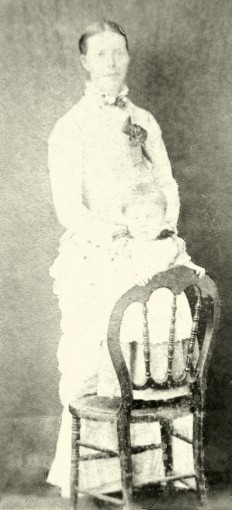
Mary with possibly son James

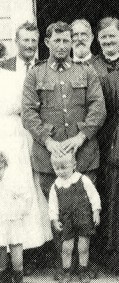
Mary's son Richard

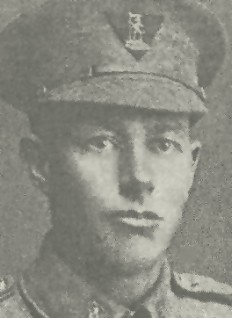
Mary's son Richard


Mary's son George

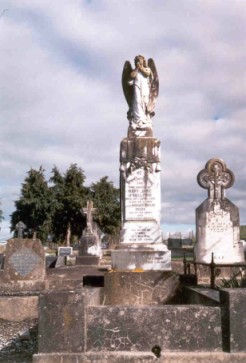
Mary's Grave
|
 1856 - 1919
1856 - 1919 
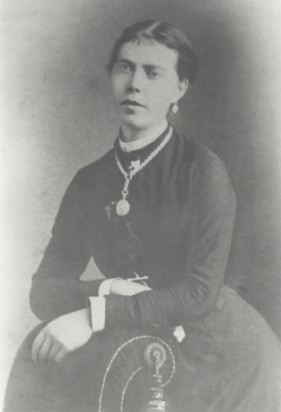
 1856 - 1919
1856 - 1919 















